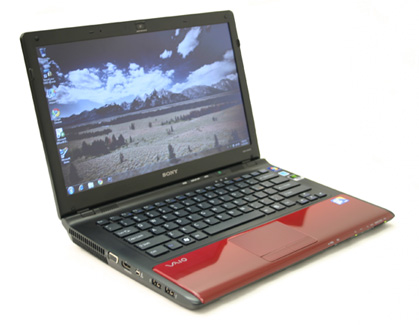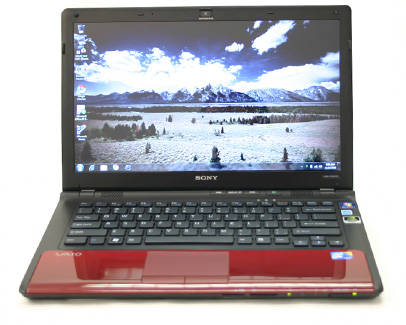“The Vaio CW Series won't challenge Sony's dramatically thin X Series for portability or style, but what it lacks in slender dimensions, it makes up in power and value.”
- Reasonably priced
- Supremely comfortable palm rest, trackpad and keyboard
- Attractive automotive-like finishes
- Solid build quality
- Crisp 14.1-inch LED-backlit screen
- Discrete graphics standard
- Perky desktop and video performance
- Respectable gaming performance
- Not particularly light or slim
- Poor battery life
- Anemic speakers
 Introduction
Introduction
Perhaps no tech company short of Apple makes style more paramount than Sony. The new Vaio CW series, however, melds Sony’s knack for sharp design with a trait more foreign to the company: affordability. The fresh Vaio line of Nvidia-powered 14.1-inch notebooks charts an intelligent course between style and substance, while keeping price in check all the while, making it a great choice for the practical fashionista on a budget.
Features and Specs
Although the $719 starting price point suggests budget notebook more than a desktop replacement in the computing power department, the Vaio CW makes few concessions to price. Every single CW includes an Nvidia GeForce graphics card – either the GT210M with 256MB of RAM in the base unit, or the GT230M with 512MB in higher end units. Both fall toward the bottom of the Nvidia line, but put Intel integrated graphics found on many machines in this price range, such as Asus’ UL30A, to shame. The base unit comes equipped with a Pentium Dual Core processor rather than a Core 2 Duo, but a $50 upgrade will bump you up to one. Other starting specs include a 250GB hard drive (upgradeable to 500GB) and 2GB of RAM (upgradeable to 8GB).

Our machine came equipped with a Core 2 Duo clocked at 2.2GHz, 4GB of RAM, and GeForce G210M discrete graphics.
Design and Build Quality
At 1.09 to 1.52 inches thick, the CW shows none of the obsession with thin that the rest of industry seems to be falling into like a gaggle of teenage girls. This is the Marilyn Monroe of notebooks, not the Paris Hilton. While it won’t catch any catcalls on dimensions alone, we think the sturdy feel more than justifies the extra millimeters here and there. It doesn’t quite challenge the unibody sturdiness of Apple’s MacBooks, but a nice set of display hinges and a reinforcement below the touchpad and keyboard keep it from ever overtly flexing, unless you go out of your way to try. Weight of 5.3 pounds is reasonable for a 14-inch notebook, but not particularly impressive.
Finish
Sony’s lust for glittery automotive-style finishes manifests itself yet again in the CW, which comes in no shortage of colors with pomped-up names like Royal Indigo and Fiery Red. Although they collect smudges and fingerprints the same way the hood of a BMW might if you managed to build a keyboard into it, we have to admit we fell for the deep luster and shine. Both the lid and palm rest come swathed in your finish of choice, with matte black overtaking the rest of the chassis.

Comfort
Unlike notebooks that seem to clam up when closed, the Vaio CW has a screen that falls just slightly short of the base when folded shut, leaving a rounded-off shelf of indicator lights and the palm rest exposed. Stylistically, it’s a miss. But we like how this design allows the palmrest to slope down to form a smooth, comfortable edge – something Apple sacrificed to style on its razor-edged MacBooks. Together with the full-size Chiclet keyboard and a matte trackpad with large and clicky right and left buttons, the CW offers one of the most comfortable typing and navigating experiences we’ve encountered on a notebook.
Ports and Connections
Despite its 14.1-inch size, the Vaio CW comes with no shortage of ports and connections, including many we’re most accustomed to finding on desktop replacements. The left side offers two USB ports, an i.LINK IEEE 1394 connector, and two flavors of video: both VGA and HDMI. The right side includes yet another USB port, dedicated headphone and analog-in jacks, along with a ExpressCard slot for expansion and of course, a built-in optical drive (CD/DVD standard, with Blu-ray as a $70 option). Around the front, you’ll find card readers for both standard SD cards and Sony’s proprietary Memory Stick Duo cards. The power connector and Ethernet jack have both been wisely relocated to the back, where they flank the battery to the left and right. In short, there aren’t many things you can’t connect this powerful notebook to.

Battery Life
Sony advertises four hours of battery life from the Vaio CW Series, but as usual, you’re looking at less after you crank brightness to acceptable levels and click on the Wi-Fi. As equipped, our demo machine eeked out about three hours with both of those options. That’s pretty unimpressive for a machine in this class, and we can’t help but wish Sony had included switchable graphics the same way Lenovo does with its T Series ThinkPads, or Apple does with its MacBooks.
Boot Time
Our Vaio CW posted somewhat inconsistent and disappointing boot times with Norton Internet Security constantly trying to pop its head up and install itself on boot, but after removing what might be the world’s worst anti-virus software, things got much better. We hit the desktop in 55 seconds and had a browser window open in another 10. Another five, and we had Wi-Fi. Not too shabby, Windows 7.
Desktop Performance
Once you hit the desktop, things get even better. The Core 2 Duo and ample RAM in our test unit allowed us to flick windows open and closed with minimal delay. Snapping open Google Chrome browser windows felt nearly instantaneous. The GeForce inside flexed its muscle when it came to video, effortlessly decoding even 1080p Apple MOV trailers with perfect fluidity. And there’s ample power for Photoshop and more intensive desktop applications.

Gaming Performance
Sony makes no claim to gaming performance, but with a GeForce G210M inside, we had to take the Vaio CW for a spin to see how it would perform. You won’t trade in your Alienware M17x for one, but it performed admirably for a machine in its class. Crysis pushed this machine straight to its breaking point. With all settings at medium, it managed a feeble 12 to 15 FPS – not what we could call playable. But after backing off to all settings to low, our FPS soared in the high 20s and low 30s, making forays into the jungle quite possible from a humble sub-$1,000 laptop. For a game that can bring $5,000 gaming rigs to a halt with the right settings, we would say that’s reasonable performance for a laptop in this class.
In 3DMark06, the Sony Vaio CW achieved 3,523 3DMarks – a feat not terribly impressive beside true-blue gaming PCs, but again, respectable for a 14.1-inch notebook with this price tag.
Screen
Sony’s 14.1-inch LED-backlit screen looks absolutely dazzling. Resolution of 1366 x 768 provides plenty of room to spread out windows, and the LED backlight pumps out plenty of light for viewing in brightly lit conditions. Like all glossy screens, it does catch quite a bit glare in situations with overhead lights or open windows.

Speakers
Like most notebook speakers, the Vaio CW doesn’t deliver much oomf from the tiny speakers embedded just above the keyboard. We don’t ever expect notebook speakers to crank out a good rendition of Du Hast, but the little guys in the Vaio CW struck us as particularly anemic – easy to talk over, even at full volume, and hampered by distortion at that level as well.
Conclusion
The Vaio CW Series won’t challenge Sony’s dramatically thin X Series for portability or style, but what it lacks in slender dimensions, it makes up in power and value. Frankly, the Vaio CW put a smile on our faces every time we found another excuse to use it. Sony’s emphasis on comfort and usability over having the right numbers has forged a likeable, well-rounded notebook that’s up for just about anything, and sleek enough to show off, too. Poor battery life and above-average weight don’t particularly recommend the CW for travel, but neither one hampers it severely enough to leave at home, either. Say hello to one of Sony’s most practical notebooks yet.
Highs:
- Reasonably priced
- Supremely comfortable palm rest, trackpad and keyboard
- Attractive automotive-like finishes
- Solid build quality
- Crisp 14.1-inch LED-backlit screen
- Discrete graphics standard
- Perky desktop and video performance
- Respectable gaming performance
Lows:
- Not particularly light or slim
- Poor battery life
- Anemic speakers
Editors' Recommendations
- Acer’s new gaming laptop bring Nvidia RTX 40-series GPUs under $1,000
- SteelSeries Prime Wireless mice, Arctis Prime headset review: Gaming prime time?
- Nvidia RTX 3080 vs. Microsoft Xbox Series X vs. Sony PlayStation 5



